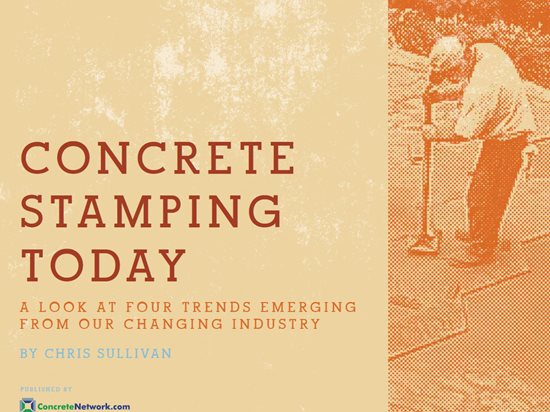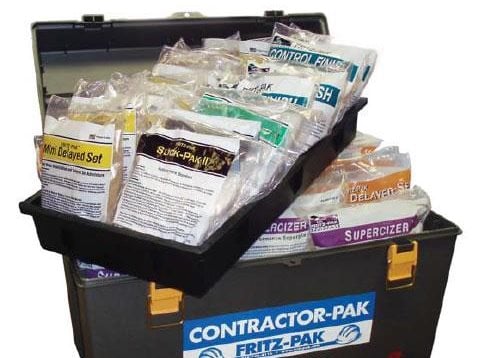- Concrete Stamps
- Get the Look - Stamping Pictures
- Buying Tips for Concrete Stamping Tools: Advice that will help you make smart choices
- Concrete Stamp Cost
- Types of Concrete Stamps: A comparison chart of popular stamps & patterns
- Stamping & Texturing Tools
- Concrete Stamp Mats
- Concrete Texturing Skins
- Medallion Stamps
- Texture Rollers
- Step Forms & Liners
- Installing Stamped Concrete
- How to Stamp Concrete
- Coloring Stamped Concrete
- Concrete Stamp Release Agent
- Sealers for Stamped Concrete
Concrete Stamping Hindsight: ‘If I Knew Then, What I Know Now’
Experienced stamped concrete contractors share the lessons they’ve learned, and the mistakes to avoidAn interesting way to look at the changes the stamped concrete industry has undergone over the last few decades is to ask stamped concrete installers who have been at it for a while: “If I knew then, what I know now.” The responses are as diverse as the industry itself, but there are some common mistakes that those new to the industry can learn from.
Free E-book:
Concrete Stamping Today
Discover four emerging trends in concrete stamping from ConcreteNetwork.com’s new e-book. You’ll also get insights and advice from veteran installers that will help you stay profitable in today’s market.
Download Concrete Stamping Today (PDF)
Learn how to run a businessMost of the troubleshooting calls I handle dealing with stamped concrete all come back to investment, or lack thereof. Not making an investment in stamps, hands-on training, or education in how to run a business better hurts the installer as well as the industry.
“No doubt, I wish back then I would have taken the artist cap off and understood the importance of running and managing the business side,” says Bob Harris of the Decorative Concrete Institute, Temple, Ga. “There are phenomenal artists and craftspeople that need a tremendous amount of educating when it comes to running a successful business.”
Another interesting place where wisdom gained from experience has changed the way installers run their business is in how they write contracts. C.J. Salzano of Salzano Custom Concrete, Centreville, Va., says that each year the fine print on his contracts gets a little longer and or more detailed. This is the result of dealing with clients whose expectations of stamped concrete are unrealistic as well as working in a business where everything changes with each job.
Watch the weatherStamped concrete is not manufactured in a controlled plant environment. Each project comes with a different set of variables, including weather conditions, location, logistics, and raw materials. One of the things Salzano wishes he knew more back then was when to postpone a pour. “Eight years ago, we would pour concrete even when the forecast called for a 30% chance of rain. Today, we will call a pour if there is a 20% chance of rain, and even then I am watching the sky, making a game-time decision,” he says. Having to replace or repair a large job due to rain or some other environmental condition is expensive and a hard lesson to learn.
Check out our seasonal pouring tips organized by region.
Use chemical admixturesAn option that was relatively nonexistent for stamped concrete contractors a few decades ago were chemical admixture for concrete. It wasn’t until Brad Walker of Lone Star Concrete Systems, Watauga, Texas, had been stamping concrete for three years before he even heard about retarders and other admixtures for controlling his concrete. He learned at the school of hard knocks when it came to controlling concrete, as the North Texas summer heat was brutal and unforgiving when it came time to stamp. “I wish I had known more about these admixtures, or better yet, I wish they existed when I first started stamping concrete,” he says. Gaining a better understanding of the science of concrete, along with the wide range of chemicals available today to help with strength, set time, and flowability, was a common theme with most everyone I spoke with.
Maximize your productivityAnother area Walker wishes he knew more about back then was how to be more productive. He has learned from years of experience that his company makes money when his crews are stamping concrete. This means that all the time his crews spend grading sites and setting and tearing down forms is money out of his pocket. Of course, this is part of every stamped concrete job, but a lesson Walker learned through hard work and time on the job came a few years back when Lone Star started doing what he calls production work. “Our crew just does the stamping,” says Walker, who now partners with a few larger concrete general contractors. Instead of these GCs subbing out the highly specialized stamped concrete portion of the project, as they had in years past, they bid the work as if they are going to do it. The twist is that they do all the site work and forming, including pouring the concrete, and when it comes time to do the highly specialized work, they have the Lone Star crew step in and perform that part of the job. “I provide a specialized crew to the GC, and they do the stamping,” says Walker. Instead of doing one job a day, Walker’s specialized stamping crews can do multiple jobs because they are only stamping the concrete, nothing else. All the labor rates are negotiated far in advance, and the stamp crew knows where and when they will be needed for production work weeks in advance. “I wish I had thought of doing this years ago,” says Walker. “I know this won’t work in every market, but it’s a great way for us to generate high profits and productivity from a highly specialized crew.”
 Ashlar Cut Slate Stamp
Hand-tooled with a pronounced texture
Ashlar Cut Slate Stamp
Hand-tooled with a pronounced texture
 Herringbone Used Brick
Tool Size is 44" x 27"
Herringbone Used Brick
Tool Size is 44" x 27"
 Rock Salt
Seamless travertine off-set
Rock Salt
Seamless travertine off-set
 Bluestone Texturing Skin
6 skin set - only $1,173.20
Bluestone Texturing Skin
6 skin set - only $1,173.20
 Five Point Star Medallion
Concrete stamp only - $292.00
Five Point Star Medallion
Concrete stamp only - $292.00
 Brickform Stamping Tools
Precision stamping tools
Brickform Stamping Tools
Precision stamping tools







